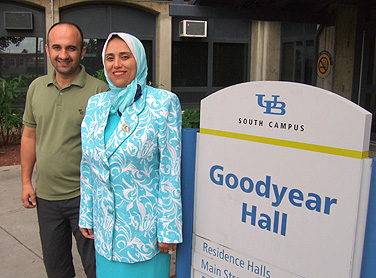This article is from the archives of the UB Reporter.
News
UB first stop for Humphrey Fellows

Tasawar-ul-Karim Baig and Amany Soliman say they've enjoyed their days at UB acclimating to a new academic environment. Photo: LAUREN NEWKIRK MAYNARD
-
 Print
Print -
 Comments
(1)
Comments
(1)
-
“I believe in mutual, cultural exchange, and I wanted to take advantage of experiences within the U.S. educational system and bring it back home to my country.”
One thing becomes clear in the third-floor lounge of Goodyear Hall, as Hubert H. Humphrey Fellows Amany Soliman and Tasawar-ul-Karim Baig begin their stories: Everyone is a fan of “Knight Rider,” the 1980s TV show.
“I grew up watching ‘The Fall Guy’ and ‘Knight Rider,’” says Baig, a senior producer for Express News, which he says is Pakistan’s largest television news network. “So did I,” laughs Soliman, who lives in Assiut, Egypt, and is an assistant lecturer of education at Assiut University. “I loved Michael Knight … he was so handsome.” Both Soliman and Baig are Hubert H. Humphrey Fellows, on a brief visit to UB this summer before they move on to Pennsylvania State University and the University of Maryland, respectively. Around 160 international applicants are accepted each year to the Humphrey Fellows Program, a Fulbright Program activity funded by the U.S. State Department and run by the Institute of International Education (IIE). More than 3,700 fellowships have been granted by the program since it began in 1978. At the end of July, 17 fellows visited UB for three weeks of pre-academic orientation programming run by the UB English Language Institute (ELI), part of the Graduate School of Education. UB is one of several institutions subcontracted through IIE to run the fellowship’s on-campus orientation program. The program is a cultural exchange with a professional twist: International fellows with previously limited experience in the United States spend ten months in non-degree academic studies and related professional experiences at 15 host institutions across the country. Applicants to the competitive program are mid-career professionals in fields that include agriculture, education, communications, finance, health care and public policy, and are chosen for their leadership potential and their commitment to public service in the public or private sectors. In the next few weeks, the Humphrey Fellows will leave at different times for their assigned schools, whose academic strengths have been matched to the fellows’ professional interests. “This is our fourth year doing the Humphrey Fellows pre-academic program,” says Keith Otto, ELI’s program director, adding that UB got involved through its experience administrating previous Fulbright exchange orientations. Sometimes, he says, IIE sends foreign visitors to UB to take ELI’s intensive English language training program for a semester, before they become fellows, in order to boost their language skills before they apply to fellowships like the Humphrey Program, which requires a baseline competency in English. Soliman and Baig are trained in different fields—education and broadcast journalism—but their reasons for applying to the program are similar. “I believe in mutual, cultural exchange, and I wanted to take advantage of experiences within the U.S. educational system and bring it back home to my country,” Soliman says. Her focus is on higher education administration, and her goal, she says, is to observe Penn State’s faculty and how they conduct quality assurance “within the context of a graduate-level, accredited environment.” Baig speaks four languages in addition to his native Urdu, and has studied at the Sydney Film School in Australia. He says he has always been “fascinated with communication, broadcast media and American film.” He thought the Humphrey Fellows program would give him the opportunity to learn more about creating balanced, high-quality news programming, and how the U.S., in particular, produces it. “America is at the top of my trade,” he says. An avid consumer of national and international politics, Baig also wants to gain the technical skills needed to bring Pakistan to a more global audience. With the recent violence in Karachi and widespread floods throughout the country, he knows this is a serious time to be working in news. “So much is happening right now, there is a lot to say,” he says. “I want to capture stories and educate people on what they should do during a crisis. I also want to change the world’s perception of Pakistan … to help other countries connect more with the common people.” Both fellows say they were thrilled to learn that they were headed to the United States, and have been enjoying their days at UB acclimating to a new academic environment. “Your institutions are highly regarded in our countries,” Baig says. Although he has visited Chicago and some family members in Wisconsin, he hadn’t previously been to New York or Maryland, where he will attend classes at the Philip Merrill College of Journalism in College Park. Soliman said that the fellows enjoyed a recent field trip to Niagara Falls, likening it to the man-made wonders in Egypt, the Great Pyramids of Giza. “People are just so friendly and helpful here, it’s been a wonderful start,” she says of Buffalo. She hopes to take her fellowship experiences back to Egypt to help it become more competitive in the global market. “If you have a well-organized educational system—especially in higher education—then you will give the market more highly qualified people who can help improve society,” she says.

Reader Comments
Surajit Sen says:
If I understand correctly, Humphrey selection is done by expert panels organized and run by US Education Foundation in that country. IIE is an outfit that liaisons (usually very poorly) with the state department and plays no role in the selection process let alone running it. Thus, due credit perhaps should be given to the programmatic experts in these nations which go through great efforts to do the fellow selection.
Posted by Surajit Sen, Professor of Physics, 08/08/10